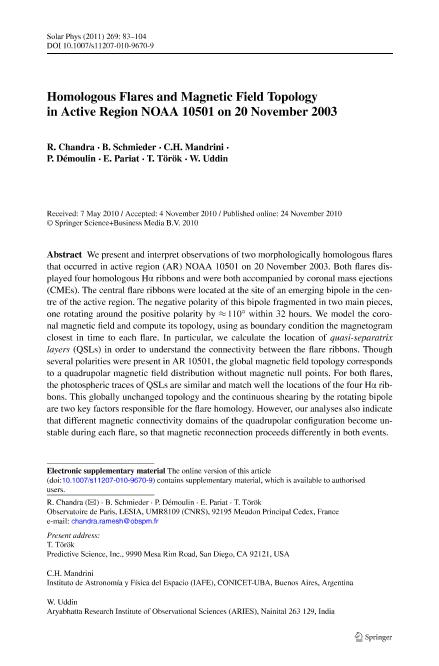Mostrar el registro sencillo del ítem
dc.contributor.author
Chandra, R.
dc.contributor.author
Schmieder, B.
dc.contributor.author
Mandrini, Cristina Hemilse

dc.contributor.author
Démoulin, Pascal

dc.contributor.author
Pariat, E.
dc.contributor.author
Torok, T.
dc.contributor.author
Uddin, W.
dc.date.available
2017-07-05T18:46:36Z
dc.date.issued
2011-03
dc.identifier.citation
Chandra, R.; Schmieder, B.; Mandrini, Cristina Hemilse; Démoulin, Pascal; Pariat, E.; et al.; Homologous flares and magnetic field topology in active region NOAA 10501 on 20 November 2003; Springer; Solar Physics; 269; 1; 3-2011; 83-104
dc.identifier.issn
0038-0938
dc.identifier.uri
http://hdl.handle.net/11336/19625
dc.description.abstract
We present and interpret observations of two morphologically homologous flares
that occurred in active region (AR) NOAA 10501 on 20 November 2003. Both flares displayed four homologous Hα ribbons and were both accompanied by coronal mass ejections (CMEs). The central flare ribbons were located at the site of an emerging bipole in the centre of the active region. The negative polarity of this bipole fragmented in two main pieces, one rotating around the positive polarity by ≈110° within 32 hours. We model the coronal magnetic field and compute its topology, using as boundary condition the magnetogram closest in time to each flare. In particular, we calculate the location of quasi-separatrix layers (QSLs) in order to understand the connectivity between the flare ribbons. Though several polarities were present in AR 10501, the global magnetic field topology corresponds
to a quadrupolar magnetic field distribution without magnetic null points. For both flares, the photospheric traces of QSLs are similar and match well the locations of the four Hα ribbons. This globally unchanged topology and the continuous shearing by the rotating bipole are two key factors responsible for the flare homology. However, our analyses also indicate that different magnetic connectivity domains of the quadrupolar configuration become unstable during each flare, so that magnetic reconnection proceeds differently in both events
dc.format
application/pdf
dc.language.iso
eng
dc.publisher
Springer

dc.rights
info:eu-repo/semantics/openAccess
dc.rights.uri
https://creativecommons.org/licenses/by-nc-sa/2.5/ar/
dc.subject
Active Regions
dc.subject
Magnetic Field
dc.subject
Flare Dynamics
dc.subject
Flares - Relation to Magnetic Field
dc.subject.classification
Astronomía

dc.subject.classification
Ciencias Físicas

dc.subject.classification
CIENCIAS NATURALES Y EXACTAS

dc.title
Homologous flares and magnetic field topology in active region NOAA 10501 on 20 November 2003
dc.type
info:eu-repo/semantics/article
dc.type
info:ar-repo/semantics/artículo
dc.type
info:eu-repo/semantics/publishedVersion
dc.date.updated
2017-07-05T15:46:59Z
dc.journal.volume
269
dc.journal.number
1
dc.journal.pagination
83-104
dc.journal.pais
Alemania

dc.journal.ciudad
Berlín
dc.description.fil
Fil: Chandra, R.. Centre National de la Recherche Scientifique. Observatoire de Paris; Francia
dc.description.fil
Fil: Schmieder, B.. Centre National de la Recherche Scientifique. Observatoire de Paris; Francia
dc.description.fil
Fil: Mandrini, Cristina Hemilse. Consejo Nacional de Investigaciónes Científicas y Técnicas. Oficina de Coordinación Administrativa Ciudad Universitaria. Instituto de Astronomía y Física del Espacio. - Universidad de Buenos Aires. Facultad de Ciencias Exactas y Naturales. Instituto de Astronomía y Física del Espacio; Argentina
dc.description.fil
Fil: Démoulin, Pascal. Centre National de la Recherche Scientifique. Observatoire de Paris; Francia
dc.description.fil
Fil: Pariat, E.. Centre National de la Recherche Scientifique. Observatoire de Paris; Francia
dc.description.fil
Fil: Torok, T.. Centre National de la Recherche Scientifique. Observatoire de Paris; Francia
dc.description.fil
Fil: Uddin, W.. Aryabhatta Research Institute of Observational Sciences; India
dc.journal.title
Solar Physics

dc.relation.alternativeid
info:eu-repo/semantics/altIdentifier/doi/http://dx.doi.org/10.1007/s11207-010-9670-9
dc.relation.alternativeid
info:eu-repo/semantics/altIdentifier/url/https://arxiv.org/abs/1011.1187
dc.relation.alternativeid
info:eu-repo/semantics/altIdentifier/url/https://link.springer.com/article/10.1007/s11207-010-9670-9
Archivos asociados
